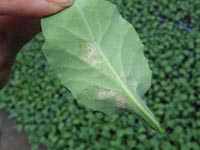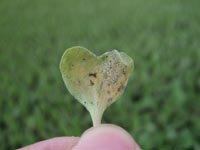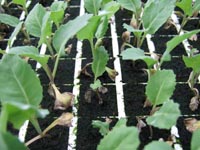Downy mildew of Brassica oleracea
The disease
Caused by the oomycete Hyaloperonospora brassicae (syn. Hyaloperonospora parasitica subs. brassica (HpB)).
It is a highly host specific pathogen. Can affect plants at all stages, but seedlings and young plants are most susceptible.
Fungicides can be used to control the disease, but repeated applications can lead to insensitive variants in the pathogen population; resistant cultivars could provide a practical, environmentally friendly alternative.



Summary of work at Warwick HRI (previously Horticulture Research International)
- Establishing a core biodiversity collection of B. oleracea
- Evaluation for the B. oleracea diversity collection for downy mildew resistance
- Development of a host differential set of B. oleracea lines
- Pre-breeding lines of ‘broccoli’ type lines with downy mildew resistance
- Molecular markers for distinguishing variants of H. brassicae
Establishing a core diversity collection B. oleracea. In 1993, a European Union commissioned project (AIR3-CT920463; led by Prof Ian Crute) established a biodiversity collection of 410 accessions, representing the natural variation that was available in a range of crop types and eco-geographical locations from six brassica genebanks (total gene pool of more than 10,000 accessions). This core collection was established to provide a shared community resource for vegetable breeding and applied genetics of valued traits such as: disease resistance, insect resistance, water use efficiency, nutrient use efficiency and seedling establishment.
Evaluation for the B. oleracea diversity collection for downy mildew resistance. Downy mildew resistance was one of three traits to launch the use of core collection as a resource for crop improvement (AIR3-CT920463). Three H. parasitica isolates (one from Portugal, two from the UK) were used to identify 45 accessions that each appeared to have some degree of downy mildew resistance in cotyledons. All of these accessions were heterogenous (mixture of susceptible and resistant), and therefore required selection of individuals and further evaluation in subsequent generations to identify uniform (true breeding) resistant lines. Twenty-two of these lines were then evaluated for spectrum of disease control against a variable collection of 12 H. brassicae isolates (see: Leckie et al. 1998. Acta Hort. (ISHS) 459:357-362). Preliminary genetic studies indicated that downy mildew resistance is conferred by 1-2 major genes in most of the selected lines.
Development of a host differential set of B. oleracea lines. Doubled haploid (DH) lines were generated from seven of the downy mildew resistance lines derived from the EU project (described above). An extensive collection of H. brassicar isolates was assembled from commercial brassica production (conventional and organic) sites in southeast, southwest, and northern England, and used to evaluate the spectrum of disease control that was potentially available in each of the DH lines. The lines were fully resistant to the entire H. parasitica collection, conferred by a single dominant gene. One line exhibited isolate specific resistance, conferred by a single recessive gene. Three lines appeared to exhibit partial, possibly “rate-reducing” resistance in an isolate specific manner. The differential reactions of all seven DH lines provided clear evidence for race variation in the pathogen (Vicente et al. 2012. Plant Pathol. 61:600-609). This project was sponsored by DEFRA (HH0916SF). The pathotypic diversity of H. brassicae isolates from B. oleracea was studied using differential lines developed in Wellesbourne, UK, and lines developed at the Technical University of Lisbon, Portugal (Coelho et al. 2012. Eur J Plant Pathol. 134:763-771). For more information, contact E Holub or Joana Vicente.
Pre-breeding lines of ‘broccoli’ and ‘cauliflower’ type lines with downy mildew resistance. The three DH that appeared to exhibit broad spectrum resistance to an English-wide sample of H. parasitica were inter-crossed and shown to share that same downy mildew resistance gene. This single downy mildew resistance gene has now been back-crossed into a ‘broccoli’ type background. Additional H.brassicae isolates were collected in 2006-07, and eventually one was found which was weakly virulent in these DH lines, indicating that the resistance could potentially be overcome by natural variants of the pathogen in the UK. These lines we fully susceptible to some H. brassicae isolates from Portugal. Alternative sources of downy mildew resistance were identified which could provide complementary disease control (Vicente et al. 2012. Plant Pathol. 61:600-609). This project was sponsored by DEFRA (HH3723SX). For more information, contact Professor E Holub or Joana Vicente.
Download hand out of poster presented at the BSPP Presidential meeting, Bath, UK, 12-14 Sept. 2007
Current work: We are sequencing representative isolates of downy mildew from brassicas and comparing genes that might be related to pathogenicity.
